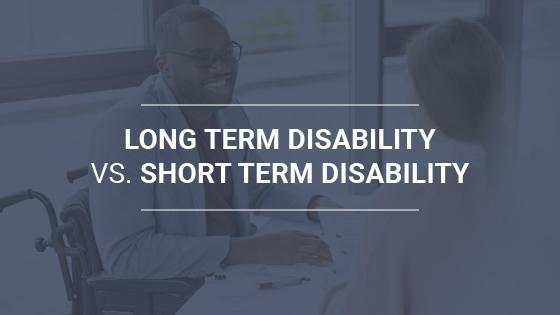
In the years since the COVID-19 pandemic, Americans have become more aware of our own mortality than perhaps at any other point in recent history. While many of us are now more familiar with how quickly we could face serious – or even life-threatening – health problems, we may not realize how common disability actually is.
According to the Centers for Disease Control and Prevention (CDC), 61 million Americans – or 1 in 4 adults – live with a disability. These impairments include everything from physical health conditions to mental health issues that affect an individual’s ability to work, take care of themselves, and perform basic life tasks.
One way to protect yourself financially is through a disability insurance policy. Disability coverage offers monthly benefits to policyholders who are unable to work due to an impairment. There are two primary types of insurance available: short-term disability insurance (STD), and long-term disability insurance (LTD).
The Differences Between Short-Term and Long-Term Disability Insurance
As noted above, there are three main differences between short-term and long-term disability policies. The biggest distinction is the period of time that you will receive benefits, which is also referred to as the benefit period.
Short-term disability policies are meant to provide benefits for a relatively short period of time after an illness or injury. Many insurance companies offer short-term policies that cover you for anywhere from 3 to 6 months.
By contrast, long-term disability policies offer benefits for an extended period of time. Depending on your plan, you may receive monthly payments for anywhere from 2 years or as long as your disability lasts – up to retirement age.
In addition to the benefit period, the coverage level also varies significantly. Again, each policy is different, but generally, short-term disability plans offer a higher percentage of income replacement (for a shorter period of time). Long-term disability coverage is usually a lower amount, for an extended period of time.
When purchasing disability insurance policies, you will typically have an option to choose your coverage level (with a higher rate of coverage costing more). Short-term plans may allow you to replace as much as 70% of your monthly income, while long-term plans may give you a choice between 40 and 70% of your income.
The next difference between the two types of policies is how long you will have to wait after becoming disabled to receive benefits. This is known as the elimination or waiting period. The clock starts to run on the elimination period on the date that you are unable to work because of your disability.
Generally, short-term disability coverage kicks in after a relatively short period of time – up to 90 days. Long-term disability benefits start after a longer amount of time – often 3 to 6 months. If you have both types of insurance, then your long-term disability benefits may start once your short-term disability benefits end.
There are a number of other differences between short-term and long-term disability benefits. For example, if you receive benefits through an LTD disability policy, then you may be required to apply for Social Security disability benefits, which will then offset your monthly disability payment. Because Social Security disability is only available to applicants who have a disability that is expected to last 12 months or longer, you won’t be required to apply if you receive STD benefits.
What Is Disability Insurance?
Disability insurance is a specific type of insurance that is designed to replace part of your income if you are unable to work due to a serious illness or injury. If you qualify for disability insurance, then you will receive monthly disability benefits to help you cover your expenses when you cannot work.
You may purchase disability insurance on your own, or through an employer. If your plan is through an employee benefits plan, then it will probably be governed by the federal Employee Retirement Income Security Act of 1974 (ERISA). Otherwise, state law governs the administration of these policies.
While each insurance policy is unique, disability insurance plans typically cover anywhere from 40 to 70% of your salary. These benefits may be paid for as little as 3 months, or through retirement age. Each policy has different rules when it comes to waiting periods, the definition of disability, and exclusions from coverage.
There are two basic types of disability insurance: short-term and long-term. There are a number of differences between the two types of policies, but the primary distinctions include the benefit period, the level of coverage, and the elimination period. A seasoned New Jersey disability benefits attorney can help you determine what type of policy you have, and what you may need to do to apply for disability insurance.
What Type of Disability Insurance Do I Need?
Disability insurance is one of the most important parts of financial planning. While you may have enough of an emergency fund to cover a few months of expenses if you were unable to work, most people cannot afford to not work for much longer – particularly if you cannot work for years.
If you can afford to purchase both types of disability income insurance, then it often makes sense to purchase both short and long-term disability plans. In this way, you will have insurance coverage for relatively short periods of time when you cannot work – and have the peace of mind to know that you will have income replacement if you are unable to work for much longer.
If two disability insurance policies are not in your budget, then your best option is to purchase an individual policy for long-term disability coverage. These types of plans are often more expensive but are a more substantial financial safety net. At the same time, focus on building up your emergency fund so that you can cover your basic expenses if you have a shorter-term illness or injury.
Can You Have Long Term Disability without Short Term Disability?
Yes. Whether you buy an individual policy or purchase a plan through your employer, it is possible to have long-term disability insurance and not short-term coverage. While most employer-sponsored plans offer the two types of insurance coverage in tandem, you should always double-check to make sure.
Of the two types of disability insurance, long-term insurance is considered more valuable – perhaps even more so than life insurance. If you have questions about a potential disability claim, contact a New Jersey disability benefits lawyer for a free consultation.
What Qualifies as a Long-Term Disability?
Almost any disability that prevents you from working may be considered a long-term disability in NJ for purposes of an LTD policy. This includes a wide range of medical conditions as well as mental health conditions. However, some policies have specific exclusions or limitations on coverage, so you will want to review your policy carefully.
One of the most critical aspects of any disability application is proving that you have an impairment that prevents you from working. Insurance companies will examine the evidence, such as medical records, to determine if you qualify as disabled – and may even send private investigators to conduct surveillance to check up on you. If you are considering applying for disability benefits, consult with a skilled attorney before starting the process.
What Happens to My Disability Insurance If I Quit My Job?
If you have disability insurance through an employee benefits plan, then you will typically lose coverage if you quit your job. However, if you are currently receiving disability benefits, you may still continue to receive them, regardless of your employment status. Long-term disability payments will often continue as long as you are disabled, or for the benefit period, even if your employer lets you go due to your inability to work.
Disability insurance benefits can be complex, and difficult to understand. Too often, insurers employ tactics designed to minimize or deny legitimate claims. If you have questions about your insurance policy, contact a New Jersey disability benefits attorney for a free claim review.
Ready to Apply? We’re Here to Help.
If you are unable to work due to a disability, you may be overwhelmed by the thought of applying for insurance benefits. The paperwork can be daunting – but you don’t have to do it alone. Our law firm is here to help.
Bross & Frankel is committed to helping individuals with disabilities get the benefits that they need. With decades of combined experience, we have the knowledge to help you achieve the best possible outcome for your disability application. To learn more or to schedule a free claim review with a New Jersey disability benefits lawyer, call us today at 856-795-8880 or fill out our online contact form.

Rich Frankel is the managing partner of Bross & Frankel. He is a member of the New Jersey and Pennsylvania bars. He has focused exclusively on disability and social security benefits since 2005.
Mr. Frankel joined what is now Bross & Frankel after having watched his father struggle with disability, fighting a lengthy illness. Mr. Frankel founded the firm’s veteran’s law practice and substantially grew the social security disability practice, focusing Bross & Frankel’s ability to fight for all of the disability benefits available to his clients.
Mr. Frankel additionally fights for clients in court, obtaining frequent victories in Social Security appeals and against insurance companies in Federal court.